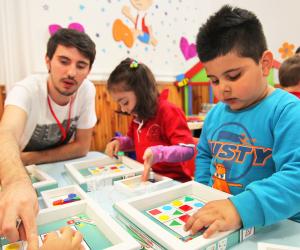
Let’s Read Fluently!
Study Overview:
Establishing a strong foundation in literacy skills for children is crucial to support their subsequent academic development (Zakaria et al., 2021). Arabic language learners face challenges in learning to read and write in Modern Standard Arabic, as it differs from the colloquial language spoken at home ("Abadzi," 2017). Data from the 2018 Early Grade Reading Assessment (EGRA) indicates that only about 19% of second and third-grade students meet or exceed the minimum levels of reading proficiency. Children may continue to face these early reading difficulties, limiting their ability to reach their full potential in the future.
This summary highlights the implementation and results of the pilot evaluations of LRF! conducted in Jordanian primary schools in 2021-2022 and in 2023-2024. The purpose of these pilot evaluations was to test the intervention’s feasibility and evidence of promise as well as assess its readiness for an efficacy trial. The pilots were also intended to provide preliminary evidence on the impact of LRF!, the mechanisms of change, and lessons to inform future scale-up. Both of these pilot studies were co-funded by the Queen Rania Foundation and the Education Endowment Foundation, and in partnership with the BHP Foundation as part of the "Building a global evidence ecosystem for teaching" project. The project was implemented by Queen Rania Teaching Academy (QRTA) and the pilot evaluation studies were conducted by British National Centre for Social Research (NatCen), in partnership with Integrated International.
Both studies applied different models for program implementation as follows:
First Pilot Study (2021-2022):
This pilot study aimed to explore the potential impact of the intervention on students’ reading abilities in the early primary years (grades 1-3) and assess the feasibility of conducting a large-scale randomized trial to better evaluate its effects. Two models were implemented during the first pilot phase, each lasting for one semester:
- Whole-Classroom Model: Targeting the entire first grade, where the classroom teacher applied the intervention material with all students three times a week for 30 minutes per session during the second semester.
- Catch-Up Model: Targeting small groups of students from the first three grades identified as the bottom 20% in their class through an assessment tool. In this model, the resource room teacher worked with second and third graders in the first semester and with first graders in the second semester for 30 minutes, three times a week, as in the whole-classroom model.
Findings from the 1st pilot study (2021-2022):
Evidence of Promise: The pilot evaluation showed evidence of promise for the whole-classroom model, with impact evaluations suggesting that this model could improve students’ literacy attainment. However, in the case of the catch-up model, there was no evidence of improvement. The pilot study had a small sample size and was not designed to measure impact robustly.
Feasibility of Implementation: The "Let’s Read Fluently" program was feasible to implement, and most schools delivered it as intended with minor adjustments. The pilot identified several potential improvements needed for the interventions, including adjustments to the training of resource room teachers in private/low-performing schools, coordination of program delivery, content of the training manual, and the process of selecting students from low-performing schools. Overall, the pilot results suggest that the whole-classroom model could potentially be scaled up to a full-scale efficacy trial.
Second Pilot Study: Catch-Up Model (2023-2024):
Since the previous study found no evidence supporting the catch-up model ("Dimova et al., 2023"), this study re-evaluated the catch-up model with a modified approach that addresses the challenges of the previous model, to determine if this approach shows evidence of promise. The model targeted 'struggling readers' by supporting a small, selected group of students lagging behind their peers in Arabic literacy skills.
Findings from second study (2023-2024):
There is preliminary evidence suggesting that the LRF! C/U model has a positive impact on oral reading fluency, syllable identification, and word decoding.
- The student screening process remains uncertain and requires further refinement.
- Teacher training and coaching mechanisms were found to be effective, but scaling remains a challenge due to operational constraints.
- A full-scale efficacy trial for the C/U model is not yet recommended based on the findings from these two pilots. Instead, a future pilot evaluation should focus on improving student selection, enhancing implementation strategies, and assessing scalability.
Given the scalability challenges associated with the C/U model, findings indicate that the W/C model is a more viable candidate for an efficacy trial. The W/C model demonstrated feasibility in reaching a larger student population while maintaining instructional effectiveness. Insights from the second C/U pilot highlight shared instructional elements that could enhance the delivery of the W/C model.
The LRF! intervention is aligned with Jordan’s national literacy priorities and holds promise for improving early-grade reading outcomes.
Findings and key highlights from both studies are summarized in the executive report in the list of documents below, available in both languages

